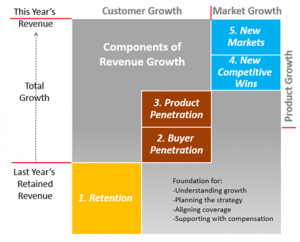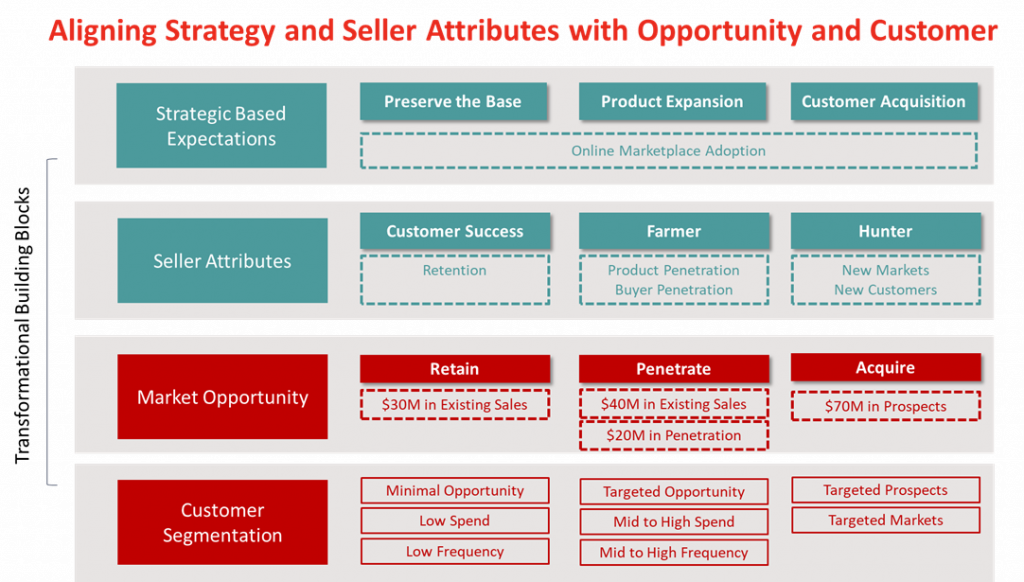The Transformational Journey to Redefine Sales

In our work at SalesGlobe, we help our clients solve challenges, navigate headwinds, and progress through transformational change as they respond to rapidly changing market needs and demands and begin to redefine sales.
One recent client challenge involves an industry where technological advancements are taking them in a downward trend over the next 10 years. Does that sound familiar? Then please read on.
Many of the traditional products that our client delivers today are losing relevance and will continue to do so over time. Today, the client is already making strides to broaden its product footprint and create new channels including an online marketplace to serve a wider customer base. Time is of the essence for this client. This pressure is leading them to reshape their business strategy, processes, and culture. They need to move fast while ensuring that they don’t disrupt their current revenue stream – the cash cow that will sustain them through this change.
This is transformational change, and it takes years to accomplish.
Transformation requires vision, perseverance, and collaboration to see it through. For the future seller, it means evaluating expectations, assessing seller attributes, gauging market opportunity, and considering customer buying behaviors.
Let’s explore four interdependent actions in this transformational journey case study that I used in my work, and that you can apply to your business today.
![]()
Transformational Action 1 to Redefine Sales – Strategy-Based Expectations
The first step is to clearly define outcome-based expectations for the sales organization. These expectations should support and drive your company strategy. The four key focus areas for the client scenario are as follows:
- Growth through product expansion: selling new products to existing customers
- Growth through customer acquisition: selling new products to new customers
- Adoption of an online marketplace: increase the number of buyers using the platform by demonstrating the benefits
- Preserve the existing base: ensure existing clients buying traditional products receive excellent service while other areas of the business continue to expand and grow
So, the expectation was clear. The sales organization must change from “order taking” and account management to product expansion and new customer acquisition. In other words, they need to transform into a sales culture. This is no easy task when you consider that the current sales organization has an average tenure of 10+ years.
So, on to the next question: What type of seller(s) will be needed to drive these strategic outcomes?
![]()
Transformational Action 2 – Attributes of the Salesperson
The second objective is to evaluate the current sales organization and to understand what sales attributes are needed to support and drive those strategic objectives and outcomes.
Here at SalesGlobe, we leverage components of a revenue growth model in relation to a salesperson with specific skill sets, preferences, and attributes. Let’s take a closer look at the components of revenue growth coming from customers, markets, and products.

Retention. To achieve growth, the business must have a solid revenue foundation. The seller focused on preserving the revenue base should have a service mindset and be an advocate of the customer. This role may be referred to as a “customer success manager” or a “service delivery manager”.
Buyer Penetration. This seller advocates for the customer but also has a keen sense for uncovering additional growth opportunities. This seller must be able to match customer needs with the company’s products and services. This could be finding additional buyers within other organizations within the customer’s business.
Product Penetration. In this area, the seller identifies additional product opportunities within an existing customer. In this client’s situation, the goal is to introduce the new broader product line to customers that have purchased the traditional products in the past. This seller must be skilled in making connections and building relationships. A role focused on buyer and product penetration may be referenced as a “hunter rep” or “account manager”.
New Competitive Wins. A successful seller in this space instinctively pursues untouched opportunities. They can clearly articulate the product benefits and can illustrate the advantage over the competition. This seller is not discouraged by rejection but takes it on as a challenge.
New Markets. This seller also pursues untapped opportunities by focusing on new markets. The goal is to develop new business in markets that the company is not currently serving. Growth comes from adding new geographic territories or moving to new industries with new products and services. Roles targeting competition and new markets are often referred to as “hunter reps” or “business development managers”.
In our client’s situation, each strategy would require a unique seller type. At SalesGlobe, we believe a salesperson has a lot more dimension than a hunter and a farmer, so we use a canine model that I think you can appreciate in describing the attributes associated with each sales role type.

- Account Manager, Retrievers – Growth through product expansion; selling new products to existing customers. The retriever is constantly alert in pursuit of new opportunities, sometimes to the detriment of protecting the current base of business. But that’s where the account manager needs to be, growing and penetrating business.
- Business Development Manager, Doberman – Growth through customer acquisition; selling new products to new customers, an alpha, always looking for new opportunities and not too shy to ask for the deal. A quintessential relationship developer always reaching out to someone new.
- Customer Success Manager, Collie – Preserve the existing base; ensure existing clients buying traditional products receive excellent service while the business continues to expand and grow. The most successful person in this role always knows what’s happening with their customer and is laser-focused on the current business at hand, ensuring everything is working with excellence, creating loyalty and preference. Therefore, individuals in this role are most satisfied when they know they are doing well by their customers, ensuring that they are getting an optimal level of service and overall satisfaction with the company’s product and service offerings.
![]()
Transformational Action 3 – Market Opportunity
The third step for this client required them to take a prescriptive approach to individual and territory growth. Transformational sales and revenue targets must be specific to the addressable expansion opportunity and new business potential. Targets should be realistic and supported by quantifiable opportunities and potential.
In order to truly redefine sales, goal setting should take a top-down, bottom-up approach. This requires taking a hard look at the current customer base and the total addressable market. The client performed an analysis of their current customer base along with prospects in other markets, channels, or verticals to relate them to one of the five areas below:
- Retain.What customers have limited to no growth potential? Access the customer that may be a retention risk.
- Expand.What customers have whitespace opportunities? Analyze current customer product and services mix to identify areas for product expansion and new product introduction.
- Acquire.What prospects have greenfield opportunities and are in need of or desire the company’s new products? Design a strategy to take market share from the competition.
- Penetrate.What new verticals and channels may benefit from the new products? Look for innovative ways for the company and new products to gain entry into that space.
Taking this action to align opportunity to the company strategy and the appropriate seller skill. Understanding the market opportunities goes hand in hand with understanding the customer and prospect buying behavior and traits.
![]()
Transformational Action 4 – Customer Segmentation
As part of this transformation, SalesGlobe recommended that the client evaluate current and prospective customers through the lens of segmentation. Segmentation is the grouping of customers based on shared needs, behaviors, or actions. Segmentation allows the business to align strategic objectives with customer characteristics.
Here are a few ways to approach customers and prospects:
- Buyer Vertical or Channel
- Buyer Opportunity
- Buyer Sophistication
- Buying Levels
- Buying Frequency
- Product Opportunity
The outcomes of segmentation can be far-reaching for both the business and customers. The largest impacts we see are in the strategic areas that our client is targeting. They found that segmentation:
Improves Business Focus. Salespeople service customers based on similar needs, traits, and behaviors. Each person’s skill should align with both customer needs and business objectives.
Boosts Revenue. With a “divide and conquer” approach, salespeople can focus on the specific product needs and revenue opportunities. Some salespeople may focus purely on customer acquisition opportunities while others may focus on smaller existing repeat business.
Promotes Product Expansion. Identify the customers with the desire or need for new products. Align your sales organization to meet those opportunities.
Optimizes Customer Experience. Consider looking at customers based on buying preferences like online ordering, phone ordering, or in-person visits.
Breaks into New Markets. Identify territories/markets/channels with the highest potential. Some salespeople may focus solely on franchises or vertical markets for example.
Moreover, our client looked at all customer segmentation approaches. For instance, they realized that buyer sophistication would play heavily into which customers had an appetite for online buying versus contacting a seller. Also, lower level or frequency buyers may be better served by a customer success manager.
![]()
Pulling Together the Transformational Action
Each of these actions is interdependent and when combined, make the building blocks for transformational change.

When undertaking a transformational change, all four areas need to be evaluated and aligned. Each business strategy takes the skill of a unique salesperson. For an individual to reach the optimal level of performance, a clear understanding of the market opportunity and customer traits and behavior they serve must be understood and aligned. This is the future salesperson to make the transformational journey to redefine sales.
![]()
SalesGlobe is a leading sales effectiveness and data-driven creative problem-solving firm. We specialize in helping Global 1000 companies solve their toughest growth challenges and helping them think in new ways to develop more effective solutions in the areas of sales strategy, sales organization, sales process, sales compensation, and quotas. We wrote the books on sales innovation with The Innovative Sale, What Your CEO Needs to Know About Sales Compensation, and Quotas! Design Thinking to Solve Your Biggest Sales Challenge.

Director of Consulting with SalesGlobe.
Sales operations leadership, working with clients to drive positive change, productivity and performance.




